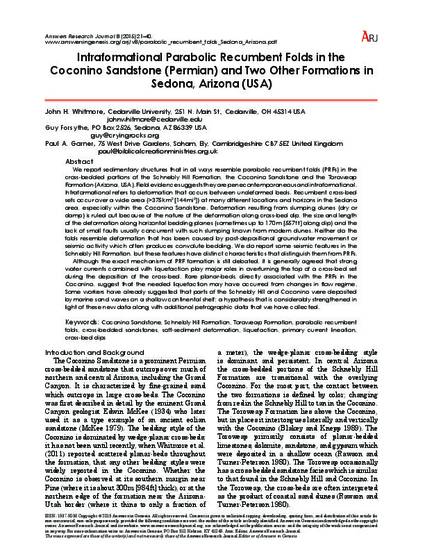
We report sedimentary structures that in all ways resemble parabolic recumbent folds (PRFs) in the cross-bedded portions of the Schnebly Hill Formation, the Coconino Sandstone and the Toroweap Formation (Arizona, USA). Field evidence suggests they are penecontemporaneous and intraformational. Intraformational refers to deformation that occurs between undeformed beds. Recumbent cross-bed sets occur over a wide area (>375 km2 [144 mi2]) at many different locations and horizons in the Sedona area, especially within the Coconino Sandstone. Deformation resulting from slumping dunes (dry or damp) is ruled out because of the nature of the deformation along cross-bed dip, the size and length of the deformation along horizontal bedding planes (sometimes up to 170 m [557 ft] along dip) and the lack of small faults usually concurrent with such slumping known from modern dunes. Neither do the folds resemble deformation that has been caused by post-depositional groundwater movement or seismic activity which often produces convolute bedding. We do report some seismic features in the Schnebly Hill Formation, but these features have distinct characteristics that distinguish them from PRFs.
Although the exact mechanism of PRF formation is still debated, it is generally agreed that strong water currents combined with liquefaction play major roles in overturning the top of a cross-bed set during the deposition of the cross-bed. Rare planar-beds, directly associated with the PRFs in the Coconino, suggest that the needed liquefaction may have occurred from changes in flow regime. Some workers have already suggested that parts of the Schnebly Hill and Coconino were deposited by marine sand waves on a shallow continental shelf; a hypothesis that is considerably strengthened in light of these new data along with additional petrographic data that we have collected.
- Coconino Sandstone,
- Schnebly Hill Formation,
- Toroweap Formation,
- parabolic recumbent folds,
- cross-bedded sandstones,
- soft-sediment deformation,
- liquefaction,
- primary current lineation,
- cross-bed dips
Available at: http://works.bepress.com/john_whitmore/59/
